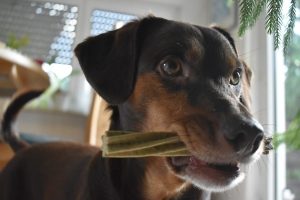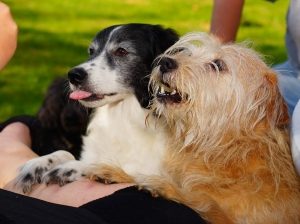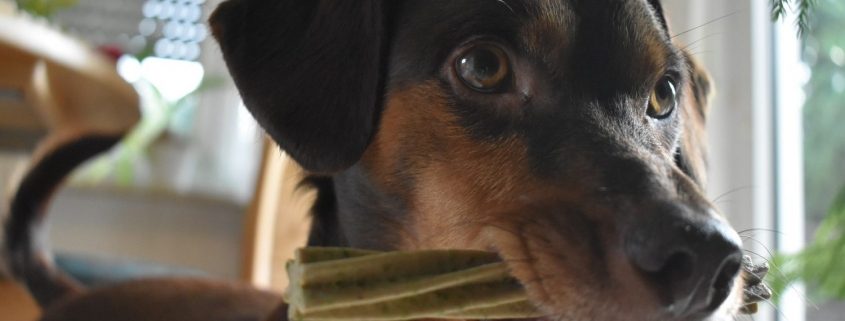Ask Crystal: Treat Hog
Welcome to “Ask Crystal,” where you can ask your pet behavior questions! You can submit your question for Crystal at the bottom of the page!

Dear Crystal,
I recently adopted a young female dog. So far everything is going really well. She gets along well with my other dog. They have lots of play sessions and snuggle time. The only thing that is concerning me is that I noticed she was growling at him over a treat ball I gave her. Then she was growling at him when he just approached the spot where the treat ball was. He walked away so nothing happened but I am worried about this behavior. What should I do to try to fix this now before it gets worse?
Sincerely,
Worried Mom
Dear Worried,
Resource guarding is actually a really normal dog behavior. In the wild, if a dog doesn’t protect what is his, he might not eat. The issue that most people have with resource guarding or any type of aggressive displays is the concern that the dog will become more and more aggressive and in other situations. It is also really disconcerting to see your sweet little angel suddenly snarling over a bone.
There is some truth to the fact that aggressive behavior can get worse in many cases. Behavior does not tend to improve with time without intervention. If you have two dogs that are guarding items on a daily basis from each other, that creates tension between the two dogs. The old adage that you should let dogs work it out on their own is often not the right way to approach dog problems. The fact is that dogs do sometimes need us to step in on their behalf.
A correction is a behavior utilized by an individual to communicate to another that they have made that individual uncomfortable and a behavioral change between the two is warranted. We should look for the receiver responding to the correction and adjusting the interaction. Pay attention to what caused the correction so that you can manage potential triggers if necessary.
Low Level corrections may include turning their head away, lip lick, change in mouth status or a whale eye from the dog guarding. A moderate level correction may include a freeze, lip lift, soft growl and/or hard stare. Moderate to High Level may include an air snap, low Growl, barks or yips toward individual and/or a muzzle punch. High level may include a grab/hold on offending party paired with direct eye contact and/or inhibited bite. The highest level correction would be an uninhibited bite.
Corrections should escalate from low to high. Most dogs can ritualize this aggression but some dogs may skip steps. However, if you have a dog that is jumping immediately to highest levels, this is a situation that needs immediate intervention with help from a Certified Professional Dog Trainer or Behaviorist. https://www.ccpdt.org/dog-owners/certified-dog-trainer-directory/
It sounds like in this case, the dog guarding offered a moderate correction and the receiver responded appropriately by walking away. This is the way that dogs communicate with each other. She was saying, “Hey, this is mine, back off.” And he responded, “Alright, I got it.” If this happens infrequently and the receiver always responds appropriately then the sender knows what level of correction to use to get the message across. If the other dog backs off, then they need not escalate.
The good thing about this type of aggression is that it tends to be very predictable and very situational. This makes it easier to manage. I would suggest practicing management just to be safe and preserve the relationship. Especially since the two dogs don’t really have a long history together.
Start by writing out any situations that seem to cause a reaction of any level of discomfort and write down the reactions of both dogs and include your response. It is important to prevent incidents as much as possible. Dogs learn from every interaction and they can learn some things that we don’t want them to.
 Be sure to feed meals at specific times rather than free feeding. There are a lot of good reasons to schedule feeding but for this purpose, it is important so that you can also put the dogs in separate rooms or areas to feed. Give them a specific amount of time to eat and then pick up the bowls until the next meal. It may take a couple meals for them to get used to but they will not let themselves starve.
Be sure to feed meals at specific times rather than free feeding. There are a lot of good reasons to schedule feeding but for this purpose, it is important so that you can also put the dogs in separate rooms or areas to feed. Give them a specific amount of time to eat and then pick up the bowls until the next meal. It may take a couple meals for them to get used to but they will not let themselves starve.
Pick up all toys and treats from the house if that is something that is being guarded. You may also want to play separately with certain toys or high intensity games for now. Some dogs will guard a toy if they are in the middle of playing a game and the other dog approaches. Special treats like enrichment toys, and chews can be given in separate rooms or crates for crate training.
Work on impulse control training with both dogs. Resource guarding can be exacerbated when you have a dog with an inability to wait for the things they want. Wait means for the dog to pause forward movement. This is really useful for preventing bolting doors but also for rushing towards a resource. Leave it means to take your nose or mouth off of whatever it is going towards or on. If you drop food on the floor, a well-trained leave it is essential. Stay is really helpful in many applications especially when you have multiple dogs. You can also teach a place cue to teach a dog to stay on a bed while you are cooking, eating or people are coming in the door. If you are having the dog stay in one location for a while, a place cue might be more comfortable because they can shift positions as long as they don’t get off the bed.
 A great exercise in prevention is to give the other dog a treat and then treat the guarder. Require that both dogs be polite and calm first. Rude pushy behavior should not be rewarded and could result in an argument. With many repetitions the guarding dog is classically conditioned that when the other dog gets a treat it’s a good thing and he will get one if he waits his turn. I would not suggest doing this in close proximity if the dogs were having altercations.
A great exercise in prevention is to give the other dog a treat and then treat the guarder. Require that both dogs be polite and calm first. Rude pushy behavior should not be rewarded and could result in an argument. With many repetitions the guarding dog is classically conditioned that when the other dog gets a treat it’s a good thing and he will get one if he waits his turn. I would not suggest doing this in close proximity if the dogs were having altercations.
Overall, it doesn’t sound like anything inappropriate is going on. It is a careful balance of working to prevent further tension without adding to it by over reacting. If you manage the situations in which dogs are likely to guard, that will go a long way to preventing issues. You may find that as the dogs get to know each other they start to relax and no longer have an issue. Or it may be a lifelong behavior that you just need to manage.
Until next time,
Crystal







